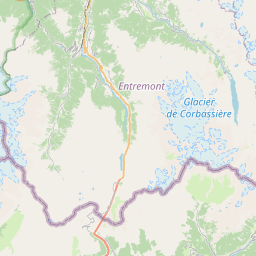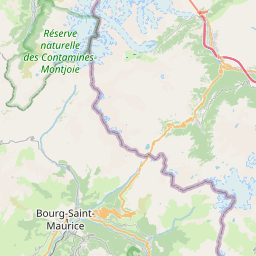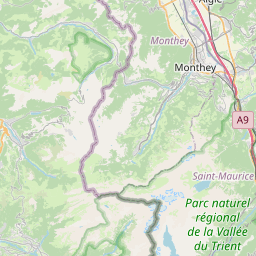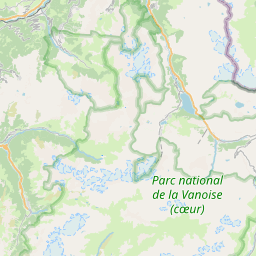Tour du Mont Blanc
The Tour du Mont Blanc (TMB) loops through France, Italy, and Switzerland around the Mont Blanc massif. It’s about 166 km with over 10,000 m (32,700 ft) of elevation gain — a beautiful alpine circuit.
We hiked it in early October 2024, after I'd spent part of the summer on the Sierra section of the Pacific Crest Trail. That’s where I met Dr. Pepper and Ranger — two hikers who had to end their thru-hike early because of forest fires. I suggested they come to Europe to keep the adventure going. A few weeks later, we reunited in France to hike the TMB together, with plans to continue on to Corsica’s GR20 after.
Most people hike the TMB in July or August, when the weather is warmer and the mountain huts (refuges) are open. In October, though, it’s a different trail. The refuges are mostly closed, the crowds are gone, and early signs of winter start to creep in. We had the mountains almost entirely to ourselves — just three hikers, our packs, the mountains, and the start of fall. It was cold, wild, and peaceful and exactly what we were looking for.
Day 0: Arriving in Geneva
We flew into Geneva, grabbed a carpool to Les Houches, and started the trail late in the afternoon. Most shops and restaurants were already closed for the season, so after snapping some photos at the trailhead, we set off.
Day 1: Les Houches to Bionnassy
| Distance | Elevation |
|---|---|
| 8.8 km (5.5 mi) | 744 m (2446 ft) ↗️ / 393 m (1,289 ft) ↘️ |
We followed the roads out of town and began the tough climb up to Col de Voza. Along the way, we stopped often to enjoy the stunning views and catch our breath as our legs adjusted to the steep climb.
That evening, just before dark, we found a quiet spot in the forest near Bionnassay to set up our tents and rest for the night.
Day 2: Bionnassay to Les Chapieux
| Distance | Elevation |
|---|---|
| 26.9 km (16.7 mi) | 1,631 m (5,352 ft) ↗️ 1,417 m (4,649 ft) ↘️ |
On our first full day on the trail, we climbed up to Col du Bonhomme. Locals had warned us there might still be snow at the pass. It had snowed the week before, but no new snow had fallen for a few days, so we hoped it wouldn’t be too bad. When we reached the top, there were a few inches of snow on the ground. It was melting fast, turning into slush in places.
The refuge at the pass was closed, but the sun was shining, so we took a break to enjoy the views and let our tents dry from the light rain the night before.
Before sunset, we reached Les Chapieux and hoped the restaurant would be open. Unfortunately, it wasn’t, but we found a place to camp at the nearby site. The bathrooms were closed, though, which made things a bit tricky.
We met one other hiker there — someone hiking south on the GR 5 trail. We shared dinner together. Little did we know, this would be the only other hiker we’d meet on the entire TMB route.
Day 3: Les Chapieux to Courmayeur
| Distance | Elevation |
|---|---|
| 29.7 km (18.5 mi) | 1,495 m (4,905 ft) ↗️ 1854 m (6,083 ft) ↘️ |
Les Chapieux is where the TMB trail turns north. The next day, we followed a winding river along the valley floor, passing by peaceful sheep grazing on the green slopes. We stopped for a short break at Les Ville des Glaciers, where we spotted some rock climbers. It’s a popular spot for climbing, and watching them get ready gave us a quick break from hiking.
From there, we started the climb to Collet de la Seigne, the border between France and Italy. Ranger was ahead when he tried to cross a stream and accidentally lost his trekking poles—it slipped from his hands and floated downstream. Luckily, one got caught on a branch, so he was able to retrieve it.
As we climbed higher, the rain and wind picked up, making the ascent tough and cold. We stopped briefly at the pass, but the strong wind made us hurry down. The descent was tricky too — the trail was muddy and full of running water from the rain.
By the time we reached Rifugio Elisabetta, the trail turned into a paved road and the rain finally eased up. We took a lunch break there before pushing on, aiming to reach Courmayeur that evening, where we had booked a hotel.
We still had one last climb left for the day. It was tough — we were cold, tired, and running low on energy. But the thought of a warm meal and a cozy bed kept us going. Once we reached the top at Rifugio Maison Vieille, our energy returned, and we picked up the pace to town.
That evening, we treated ourselves to a cozy trattoria with hot pizza, pasta, and a glass of wine — the perfect way to end a hard day on the trail.
Day 4: Courmayeur to Mont de la Saxe
| Distance | Elevation |
|---|---|
| 7 km (4.5 mi) | 860 m (2,823 ft) ↗️ 93 m (305 ft) ↘️ |
The next morning, we took it slow. We made the most of our hotel stay — enjoying a big breakfast, finishing up laundry, and drying out our gear. We didn’t hit the trail until the late afternoon.
The sun was out and the skies were clear as we began a long, steady climb back into the mountains. It felt good to move again. As we gained elevation, the views kept getting better. When we reached Refugio Giorgio Bertone, we took a long break to soak it all in. The Grande Jorasses stood tall in the distance, and with the late sun lighting up the peaks, it felt like the perfect moment. We pulled out a baguette and a small bottle of wine we’d packed out from town and had a little trail picnic.
That evening, the sky stayed clear and calm. Just off the trail, we found a quiet, open spot to cowboy camp with an incredible view of the Mont Blanc massif. We laid out our sleeping bags and drifted off under a blanket of stars.
Day 5: Mont de la Saxe to Refugio Elena
| Distance | Elevation |
|---|---|
| 12 km (7.5 mi) | 543 m (1,782 ft) ↗️ 469 m (1,540 ft) ↘️ |
We woke up early to the sound of light rain tapping on our heads. After packing up quickly, we started hiking toward Refugio Bonatti. The rain picked up as we climbed, and by the time we reached the refuge, we were soaked. To our surprise — and relief — the winter emergency shelter was open. It was warm, dry, and cozy inside, so we decided to stay for a few hours to get out of the rain and warm up.
The longer we stayed, the harder it was to leave. The rain kept falling, and the shelter felt like a little haven in the mountains. But by the afternoon, we knew we had to keep moving. We set our sights on Refuge Elena, hoping it might also have an open winter room.
The hike that afternoon was tough — the rain didn’t let up, and the wind picked up too. By the time we reached Refuge Elena, we were completely drenched and chilled. Luckily, the winter shelter was open, but it wasn’t nearly as inviting as Bonatti’s. It was tucked into a damp basement with stained walls and dirty old mattresses. But it was dry, and that was enough. We set up our sleeping pads, hung our wet gear the best we could, and called it a night.
Day 6: Refugio Elena to Champieux Lac
| Distance | Elevation |
|---|---|
| 27.1 km (16.85 mi) | 1,126 m (3,693 ft) ↗️ 1652 m (5,421 ft) ↘️ |
The next morning, we packed up early and started the climb to Grand Col Ferret, the pass that marks the border between Italy and Switzerland. The trail was steep and steady, but we felt strong and kept a good pace. As we reached the top, clouds started to lift and the sun finally came out, lighting up the surrounding peaks.
The descent into Switzerland was smooth, and by early afternoon we reached the tiny village of Ferret. We were hoping to eat there, but the only restaurant was closed. So we kept going toward La Fouly, a bit farther down the valley. When we arrived, we were happy to find that the public toilets were open, and — even better — there was a supermarket and a restaurant still serving lunch. We grabbed a hot meal and stocked up on snacks.
Feeling fueled up, we decided to aim for Champex-Lac, a bigger town farther along the trail. The path followed a river and stayed mostly flat, so we were able to move quickly. After a short climb at the end, we reached Champex-Lac by early evening. We treated ourselves to a cold beer and found a cozy restaurant for dinner.
Originally, we planned to camp at a nearby campground, but it turned out to be closed for the season. So, after dark, we hiked a few more kilometers and found a spot near a quiet service road to sleep. It wasn’t ideal — there wasn’t enough flat space to set up our tents — so we cowboy camped under the stars. It was our roughest night of sleep on the trail, but we made it work.
Day 7: Champieux Lac to Vallorcine
| Distance | Elevation |
|---|---|
| 25.4 km (15.8 mi) | 1,560 m (5,120 ft) ↗️ 1763 m (5,785 ft) ↘️ |
We got an early start again as the rain began to fall. Following the mountain’s natural curves, we made our way toward Alpage de Bovine. The place was closed, but there were some picnic tables outside, so we stopped there for lunch.
After lunch, we continued on to Trient, where we paused to admire the towering mountains around us. From here, we had to choose our next route. The usual TMB path would take us up to Refuge du Col de Balme, but it was closed for the season. So, we decided to follow the UTMB route instead, which crosses the pass down to the Swiss town of Vallorcine — hoping something there might be open.
As we set off, we soon found out part of this alternate trail was blocked by a landslide. We’d already come so far, though, so we pushed on. Some sections were tricky, with downed trees and rough spots, but we managed.
We reached Vallorcine just around dinner time. Searching the town, everything seemed shut. We learned that most places don’t update their Google Maps hours for the off-season — a tough lesson. Just as we were about to give up, we spotted a restaurant. It was officially closed to the public that day, but after the owner saw us waiting, she kindly offered to make us burgers and fries once her large takeout order was done. We gratefully accepted, charging our devices and enjoying a couple of beers while we waited.
That night, with no clear place to stay, we headed to the closed campsite and set up a stealth camp. To avoid making noise, we cowboy camped once again, sleeping under the quiet night sky.
Day 8: Vallorcine to Chamonix
| Distance | Elevation |
|---|---|
| 18.25 km (11.3 mi) | 884 m (2,901 ft) ↗️ 1,158 m (3,798 ft) ↘️ |
The next day, we followed a trail that ran alongside a road down toward the Chamonix valley. But since we’d taken the alternate route the day before, we needed to climb up at Lac Blanc les Échelles to stay on the higher ground. This path was beautiful, offering stunning views of the glaciers on the Mont Blanc massif. The only downside was missing the famous metal ladders on the main TMB route.
By late morning, we rejoined the official TMB trail and could see Chamonix getting closer. For lunch, we stopped at Les Deux Aigles, sitting right above the town — it felt like we were almost at the finish line. But we kept going.
By late afternoon, we reached Bergerie de Planpraz and were feeling pretty tired. The weather forecast warned of heavy rain coming that evening, so we decided to end our hike early and take the switchback trail straight down into Chamonix.
Walking into town, we followed the UTMB route, crossed the iconic bridge, and made our way to the center. That night, we enjoyed a good meal and some drinks. We hadn’t booked a place to stay, so we found a campsite just outside town and set up for the night. It poured rain, so we were glad we’d made the right call.
The next day, we caught our ride back to Geneva, where we stayed with a friend and started getting ready for our next adventure on the GR20 in Corsica.
Reflections
The TMB felt like a perfect end to the hiking season — one last adventure before winter. It was physically demanding but never overwhelming. The rhythm of climbing and descending, the trail winding through quiet valleys and over dramatic passes, felt steady and purposeful. We had space to soak it all in.
Doing it in October made it even more special. We didn’t have the crowds or the noise — just early sunsets, frosty mornings, and golden light brushing over glaciers. The solitude gave everything more weight: meals, views, even the little challenges. Every warm sleeping bag moment or sunrise coffee felt earned.
What stood out most wasn’t any single view (though there were plenty), but how much ground we covered on foot — how the landscape slowly changed beneath us. Italian cowbells turned into Swiss lakes and then into French forests. We passed through so many places, cultures, and languages, but it all connected into one clear trail.
And more than anything, it was about sharing the experience. I was lucky to hike it with friends who showed up ready — not just physically, but mentally. Everyone had hiked before, and everyone knew how to be present in the moment. That makes all the difference.
Thanks for reading! If you have any questions or just want to chat about the race, feel free to reach out to me on Instagram: @andrewtpham.
Tips for Hiking the TMB in the Shoulder Season (Late September–October)
Hiking the TMB in October is a whole different vibe — quiet trails, closed refuges, fall colors painted across the mountains, and a real sense of solitude. It’s beautiful, but it also comes with some quirks. Here are a few things I learned along the way:
1. Bring a Tent (and Be Ready to Use It Every Night)
Most mountain refuges close by mid-to-late September. A few lower-elevation spots and hotels may still be open in towns, but don’t count on them. We camped every night except one — and we were glad to have warm sleeping bags and solid tents.
Pro tip: If its dry, cowboy camping was something we enjoyed doing so that we were more flexible on where we camped. Some refuges (like Mottets or Bonatti) have grassy areas nearby that make great campsites even if the buildings are shut.
2. Cold = Real
Mornings were often cold and wet. We woke up to wet gear and hiked with gloves on. Higher passes like Col du Bonhomme can get snow any time after September. Bring proper layers — warm base layers, a good puffy, a windbreaker, gloves, and a hat. And don’t skimp on your sleeping setup.
3. Shorter Days = Earlier Starts
With daylight hours shrinking, it helps to start earlier if you’re doing full stages — especially if you’re navigating big passes or aiming to find a good camp spot before dark. A headlamp can be handy.
4. Expect Solitude
We saw very few hikers over the whole week. That means no trail traffic, which is awesome. But it also means no one to ask for help, no backup if you get lost, and no chatting with fellow trekkers at dinner. Make sure your group is self-sufficient and knows the route.
5. Plan Resupply Points Carefully
Most shops and cafes in small villages are closed. Bigger towns like Les Houches, Les Contamines, Courmayeur, La Fouly, Champex-Lac still had grocery stores open in October, but hours were limited. We carried enough food for 2–3 days at a time and always refilled whenever we found an open shop.
Pro tip: Pack out cheese and a baguette!
6. Watch the Weather Like a Hawk
October weather is moody. We had clear days, heavy fog, rain, and a lot of wind. Check forecasts when you have signal and don’t be afraid to adjust your plans. A storm in the Alps can roll in fast and hit hard.
7. Be Flexible
Things might not go according to plan — and that’s okay. Trails could be muddy, buses may not be running, and your feet might beg for a zero day. Having extra snacks, an offline map, and an open mindset goes a long way.

















